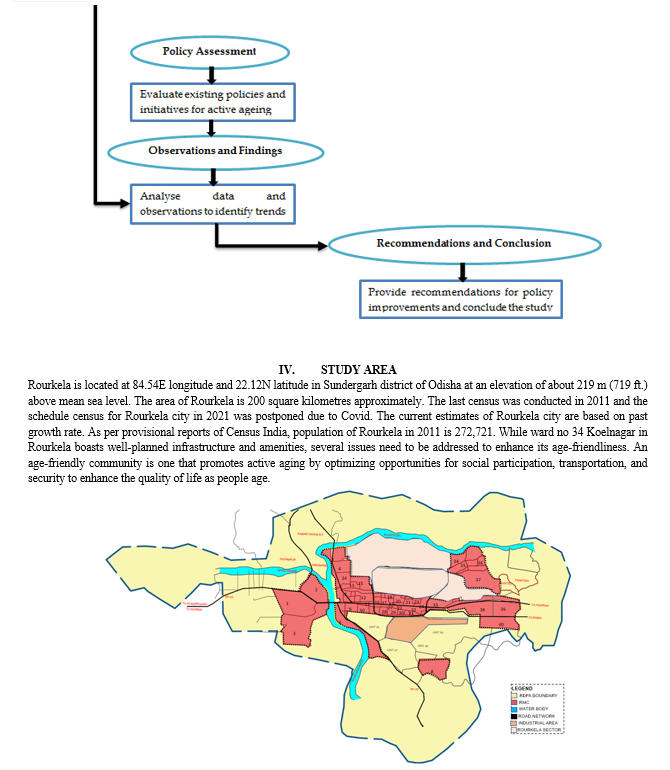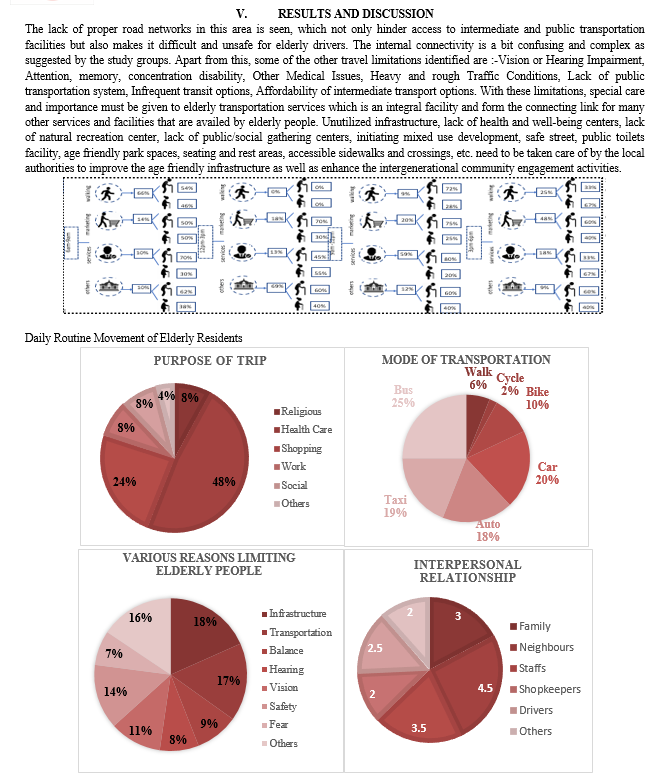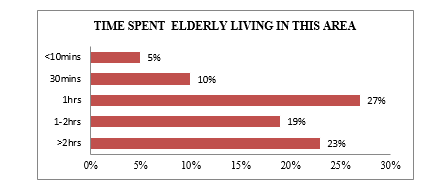Ijraset Journal For Research in Applied Science and Engineering Technology
- Home / Ijraset
- On This Page
- Abstract
- Introduction
- Conclusion
- References
- Copyright
Age-Friendly Neighbourhood Planning of Rourkela: Integrating 3 Dimensional Approach of Transportation, Social Participation and Outdoor Spaces for Elderly People
Authors: Samikshya Pradhan, Swapna Sarita Swain, Shrestha Das
DOI Link: https://doi.org/10.22214/ijraset.2024.62866
Certificate: View Certificate
Abstract
Creating a neighbourhood environment conducive to the well-being of elderly people requires a three-dimensional approach focusing on transportation, social participation, and outdoor spaces. In the physical dimension, it involves accessible public transport, well-maintained sidewalks, community centers, and green spaces equipped with safety, priority seating, ramps and adequate lighting. Outdoor spaces must include green areas with accessible paths, seating, and safety features to encourage physical activity and relaxation. The social dimension focuses on fostering community engagement through programs like community transport services, volunteer driver programs, and social hubs offering intergenerational activities. Regular support groups and opportunities for volunteering and mentorship can help build a sense of purpose and connection among elderly people.
Introduction
I. INTRODUCTION
The ageing population is a growing demographic globally, posing new issues and opportunities for urban development. Creating supportive and inclusive neighbourhoods for the elderly is critical to ensuring their well-being, independence, and quality of life. This necessitates a comprehensive, three-dimensional approach that includes transportation, social interaction, and outdoor places. Each of these categories is crucial for creating a unified environment that fits the physical, social, and technical demands of the aged. Transportation is critical to ensure that older people may keep their independence and obtain necessary services. This includes constructing accessible public transport, establishing well-maintained and safe walking trails and providing community transport services tailored to the elderly. Social participation involves creating strong community connections and offering chances for social engagement. Outdoor areas serve an important role in fostering physical and mental wellness. Accessible parks, community gardens, and safe, well-lit public areas are critical for stimulating outdoor activity while also providing opportunities for social contact and relaxation. Incorporating technological solutions along these dimensions improves connectivity and safety. Real-time travel information, virtual participation platforms, and smart infrastructure help to create an environment in which the elderly can thrive.
II. NEED OF THE STUDY
Accessible, high-quality, and affordable transportation is essential for promoting healthy and positive ageing. It facilitates access to social activities and essential services, significantly contributing to an individual's independence and autonomy. Making every part of the community accessible can greatly improve the quality of life for older adults. As people age, it's common for them to drive less and eventually stop driving altogether. While reducing driving can be a healthy, intentional decision, the need to completely stop driving or the sudden loss of access to a car can be unexpected and stressful. This often happens due to major health declines or changes in family circumstances, such as the loss of a spouse. Reliable public transportation can help alleviate these challenges by keeping older adults active and connected within their communities. The ease of walking in a local area, its safety, and the lack of obstacles are essential for all community members. A walkable environment allows people to stay active in their neighbourhood, engage in recreation and leisure, maintain fitness, socialize with neighbours, and travel from one place to another.
The walkability and accessibility of the local built environment can be enhanced through thoughtful planning, including features like benches and well-maintained paths. These improvements help ensure community members face fewer difficulties navigating their local area. Although there is extensive cross-sectional research on the benefits of transport accessibility and walkability, more longitudinal studies are needed to establish causal relationships. Future research should investigate the long-term impacts of these factors and their influence on ageing trajectories over time. Additionally, most studies are conducted in Western contexts, creating a gap in understanding how these factors operate in different cultural and geographical settings. Research in diverse contexts, such as cities like Rourkela, can provide valuable insights into the universal and context-specific aspects of transport and walkability for healthy ageing. The literature consistently emphasizes the crucial role of accessible transport and walkable environments in promoting healthy ageing. These factors improve physical activity, social engagement, and mental well-being, enhancing the overall quality of life for older adults. Incorporating these elements into urban planning and policy measures is vital for creating supportive environments that meet the needs of ageing populations.
III. RESEARCH METHODOLOGY
This study will be combining the both quantitative and qualitative data to provide a comprehensive understanding of the factors influencing the quality of life for older adults. The quantitative approach will involve data collection from older adults aged 60 and above, focusing on public transport routes, frequency, and accessibility features to analyse their convenience for older adults. Additionally, the walkability of neighbourhoods will be assessed using parameters such as sidewalk conditions, pedestrian crossings, and traffic calming measures. The qualitative approach will include semi-structured interviews and focus groups with older adults, caregivers, and community leaders to explore their experiences, challenges, and suggestions for improving the quality of life for older adults. Case study analysis will be conducted to examine age-friendly initiatives in other cities and identify transferable practices and strategies applicable.Thematic analysis will be performed on interview and focus group transcripts to identify common themes and insights related to social participation, outdoor spaces, and transportation. Expected outcomes include a holistic understanding of the factors affecting the quality of life for older adults, identification of key barriers and facilitators in creating an age-friendly environment, and the provision of evidence-based recommendations for improving social participation, outdoor spaces, and transportation. The study aims to inform urban planning and public health strategies to create more supportive environments for ageing populations and develop a comprehensive and supportive framework tailored to the needs of older adults, aligned with WHO guidelines and best practices from other age-friendly cities.




Conclusion
In this concluding chapter, we synthesize the findings and observations from the study on active ageing initiatives, with a focus on incorporating best practices for the city of Rourkela. By leveraging insights from successful case studies and research, Rourkela has the potential to emerge as a leading city in India\'s urban landscape for promoting active ageing among its population. A. Major Findings and Observations 1) Accessible Infrastructure: The provision of accessible infrastructure, including transportation, housing, and public spaces, is essential for supporting the mobility and independence of older adults. In Rourkela, there is a need to prioritize the retrofitting of existing infrastructure and incorporate universal design principles to enhance accessibility for older adults. Recommendation: Develop a comprehensive plan for retrofitting existing infrastructure in Rourkela to ensure barrier-free environments and improve accessibility for older adults. This plan should include the installation of ramps, handrails, and accessible signage in public spaces. 2) Social Inclusion: Social connections and community engagement play a vital role in promoting mental well-being and quality of life among older adults. Rourkela can benefit from the establishment of senior centres, community programs, and intergenerational activities to foster social inclusion and combat loneliness and isolation. Recommendation: Establish senior recreation centres and organize regular social events and cultural activities tailored to the interests and preferences of older adults in Rourkela. Encourage intergenerational interaction and volunteerism to promote social cohesion and mutual support. 3) Healthcare Services: Access to healthcare services, including preventive care, geriatric assessment, and chronic disease management, is critical for promoting healthy ageing. Rourkela should focus on developing integrated healthcare systems that coordinate primary care, specialty services, and social support to improve health outcomes and quality of life for older adults. Recommendation: Strengthen primary healthcare services in Rourkela by establishing geriatric clinics and promoting home-based care models and telehealth services. Collaborate with local healthcare providers and community organizations to ensure comprehensive and accessible healthcare for older adults. 4) Economic Opportunities: Economic security and meaningful employment opportunities are fundamental for older adults to maintain independence and financial stability. Rourkela can support active ageing by implementing age-friendly employment practices, lifelong learning programs, and entrepreneurship initiatives. Recommendation: Create employment opportunities for older adults in Rourkela through skill development programs, vocational training, and job placement services. Provide financial literacy workshops and pension schemes to enhance financial resilience and mitigate the risk of poverty among older adults. 5) Recreation and Leisure: Recreational activities, cultural events, and lifelong learning opportunities promote active lifestyles and contribute to the overall well-being of older adults. Rourkela can enhance its recreational infrastructure and programming to cater to the diverse interests and preferences of older adults. Recommendation: Develop age-friendly parks, green spaces, and recreational facilities in Rourkela to provide opportunities for physical exercise, social interaction, and relaxation. Organize cultural festivals, sports clubs, and volunteering initiatives to enrich the social and cultural lives of older adults. B. Rourkela: A Model City for Active Ageing in India Rourkela has the potential to emerge as a model city for active ageing in India\'s urban landscape by implementing best practices and recommendations tailored to the needs of its ageing population. By prioritizing accessibility, social inclusion, healthcare services, economic opportunities, and recreation and leisure activities, Rourkela can create a vibrant and inclusive environment where older adults can live fulfilling and active lives. C. Recommendations for Action Based on the major findings and observations, the following recommendations are proposed for action in Rourkela: 1) Develop and implement a comprehensive active ageing policy framework that addresses the diverse needs of older adults in Rourkela. 2) Establish a multi-sectoral task force or advisory committee to coordinate active ageing initiatives and monitor progress. 3) Allocate resources and funding for infrastructure improvements, social programs, and healthcare services targeting older adults. 4) Engage older adults and community stakeholders in the planning, implementation, and evaluation of active ageing initiatives. 5) Conduct regular assessments and evaluations to track the impact of active ageing initiatives and identify areas for improvement. By embracing these recommendations and committing to the promotion of active ageing, Rourkela can lead the way in creating age-friendly cities that prioritize the well-being and participation of older adults in urban life.
References
[1] Frank, L. D., Engelke, P. O., & Schmid, T. L. (2003). Health and Community Design: The Impact of the Built Environment on Physical Activity. Island Press. [2] Kerr, J., Rosenberg, D., & Frank, L. (2012). The role of the built environment in healthy aging: community design, physical activity, and health among older adults. Journal of Planning Literature, 27(1), 43-60. [3] Leyden, K. M. (2003). Social capital and the built environment: The importance of walkable neighborhoods. American Journal of Public Health, 93(9), 1546-1551. [4] Loukaitou-Sideris, A. (2006). Is it safe to walk? Neighborhood safety and security considerations and their effects on walking. Journal of Planning Literature, 20(3), 219-232. [5] Marottoli, R. A., Mendes de Leon, C. F., Glass, T. A., Williams, C. S., Cooney, L. M., Jr., Berkman, L. F., & Tinetti, M. E. (2000). Consequences of driving cessation: decreased out-of-home activity levels. The Journals of Gerontology Series B: Psychological Sciences and Social Sciences, 55(6), S334-S340. [6] Rosenbloom, S. (2009). Meeting transportation needs in an aging-friendly community. Generations, 33(2), 33-43. [7] Saelens, B. E., & Handy, S. L. (2008). Built environment correlates of walking: a review. Medicine & Science in Sports & Exercise, 40(7 Suppl), S550-S566. [8] Sugiyama, T., Thompson, C. W., & Alves, S. (2009). Associations between neighborhood open space attributes and quality of life for older people in Britain. Environment and Behavior, 41(1), 3-21. [9] World Health Organization. (2007). Global age-friendly cities: A guide. World Health Organization. [10] Buffel, T., & Phillipson, C. (2016). Can global cities be ‘smart’and age-friendly? The case of Manchester, UK. International Journal of Urban and Regional Research, 40(5), 1009-1026. [11] Scharlach, A. E., Lehning, A. J., & Roth, E. G. (2011). The impact of aging-in-place policies on the community-based long-term care system. Journal of Aging & Social Policy, 23(4), 379-395. [12] Davey, J. A., & Savla, J. (2010). Impact of telemedicine on patient self-management processes and clinical outcomes for patients with type 2 diabetes. Telemedicine and e-Health, 16(10), 1156-1169. [13] Wang, J., & Guo, H. (2018). The impact of social engagement on elderly people\'s life satisfaction: Evidence from China. Quality & Quantity, 52(1), 169-190. [14] Chatterjee, P. (2014). Sustainable urbanization and older people: Challenges and opportunities. Habitat International, 42, 204-211. [15] Wahl, H. W., & Weisman, G. D. (2003). Environmental gerontology at the beginning of the new millennium: Reflections on its historical, empirical, and theoretical development. The Gerontologist, 43(5), 616-627. [16] Phillipson, C., & Scharf, T. (2005). Older people as assets rather than dependants: The social capital of older people. Ageing & Society, 25(1), 69-82. [17] Dubey, D., Raval, S., & Acharya, J. (2017). Age-friendly cities: A framework for planning. Indian Journal of Gerontology, 31(4), 483-499. [18] Iyengar, S. S., & Bhat, C. R. (2001). Modeling the choice continuum: An integrated model of residential location, auto ownership, bicycle ownership, and commute tour mode choice decisions. Transportation Research Part A: Policy and Practice, 35(2), 93-114. [19] Velayutham, B., & Vijaya, R. (2008). Ageing in urban slums of India: A sociological study. Journal of Aging Studies, 22(2), 131-138. [20] Patel, S. A., & Patel, S. (2019). Active ageing in India: A conceptual and empirical review. Indian Journal of Gerontology, 33(3), 305-324. [21] Subaiya, L. (2011). Housing issues of the elderly in India: Implications for policy. Journal of Housing for the Elderly, 25(4), 369-387. [22] Ramamurthy, V., & Ashok, S. (2014). Active ageing: A perspective of senior citizens in Bangalore. Journal of Indian Research, 2(3), 102-114. [23] Chakrabarti, A., Chaudhury, D., & Chattopadhyay, S. (2010). Elderly in India: Their health and living conditions. International Journal of Physical and Social Sciences, 1(1), 7-20. [24] Ramanathan, S., & Palanivel, C. (2005). Community participation of elderly people: A study in Chennai, India. The Indian Journal of Social Work, 66(2), 123-134.
Copyright
Copyright © 2024 Samikshya Pradhan, Swapna Sarita Swain, Shrestha Das. This is an open access article distributed under the Creative Commons Attribution License, which permits unrestricted use, distribution, and reproduction in any medium, provided the original work is properly cited.

Download Paper
Paper Id : IJRASET62866
Publish Date : 2024-05-28
ISSN : 2321-9653
Publisher Name : IJRASET
DOI Link : Click Here
 Submit Paper Online
Submit Paper Online

